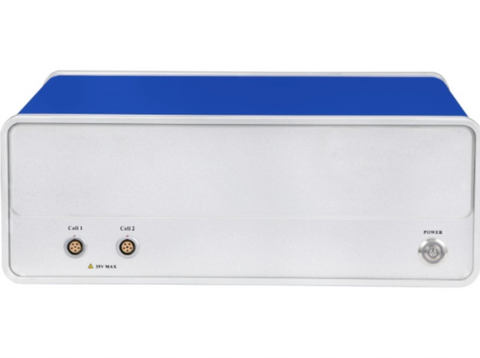
Corrtest Bi-potentiostat / Bi-galvanostat Electrochemical Workstation
SKU: SC2000
Bi-potentiostat / Bi-galvanostat Electrochemical Workstation
MSE Supplies offers electrochemical workstation (bi-potentiostat / bi-galvanostat) with built-in EIS model. It has two sets of built-in independent potentiostat /galvanosta. Each set provides full electrochemical techniques (EIS included). Experiments can be conducted simultaneously in each channel. Additionally, the two channels can jointly complete experiment of two-working electrode system (RRDE and hydrogen diffusion). With high performance in stability and accuracy with advanced hardware and well-functioned software, it is a comprehensive research platform for corrosion, batteries, electrochemical analysis, sensor, life science and environmental chemistry etc.
Customers from Australia, South Korea, India, Turkey and Kazakhstan please contact Corrtest directly.
Applications:
(1) Electrosynthesis, electrodeposition (electroplating), anodic oxidation, electrolysis
(2) Oxygen reduction reaction(ORR), oxygen evolution reaction (OER), hydrogen evolution reaction(HER), carbon dioxide reduction
(3) Energy and materials (Li-ion battery, solar cell, fuel cell, supercapacitor), advanced function materials, and sensor
(4) Corrosion behavior of metals, and anti-corrosion evaluation
(5) Fast evaluation of inhibitor, water quality stabilizer, coating, cathodic protection efficiency
Technical Specifications:
| Dimension | 365mm x 305mm x 160mm |
| Power Supply | 110V |
| Potential Control Range (Main & Slave Channel) | ± 10V |
| Potential Control Accuracy | 0.1% × full range ± 1mV |
| Potential Resolution | 10μV (> 100Hz), 3μV (< 10Hz) |
| Current Control Range | ± 1A for each channel |
| Current Control Accuracy | 0.1% × full range |
| Current Sensitivity | 1pA |
| Rise Time | < 1μS (< 10mA), < 10μS (< 2A) |
| Reference Electrode Input Impedance | 1012Ω || 20pF |
| Current Range | 2nA ~ 2A (10 ranges) |
| Compliance Voltage | ± 21V |
| Maximum Current Output | 1A |
| CV and LSV Scan Rate | 0.001mV/s ~ 10,000V/s |
| CA & CC Pulse Width | 0.0001 ~ 65,000s |
| Current Increment During Scan | 1mA at 1A/ms |
| Potential Increment During Scan | 0.076mV at 1V/ms |
| SWV Frequency | 0.001 ~ 100kHz |
| DPV & NPV Pulse Width | 0.0001s ~ 1000s |
| Potential Increment during Scan | 0.076mV at 1V/ms |
| AD Data Acquisition | 16bit at 1MHz, 20bit at 1kHz |
| DA Resolution | 16bit, setup time: 1μs |
| Minimum Potential Increment in CV | 0.075mV |
| IMP Frequency | 10μHz ~ 1MHz |
| Low-pass Filters | covering 8-decade |
| Limited Warranty | 5 years |
Electrochemical Impedance Spectroscopy (EIS)
Signal Generator:
| Frequency Range | 10μHz ~ 1MHz |
| Frequency Accuracy | 0.005% |
| AC Signal Amplitude | 0mV ~ 2500mV |
| Maximum Load Capacitance | 1nF |
| Maximum Load Inductance | 10μH |
| DC Bias | -10 ~ +10 |
| Output Impedance | 50Ω |
| Waveform | Sine wave, triangular wave and square wave |
| Wave Distortion | < 1% |
| Scan Mode | Logarithmic/linear, increase/decrease |
Signal Analyzer:
| Integral Time | Minimum | 10ms or the longest time of a cycle |
| Maximum | 106 cycles or 105s | |
| Measurement Delay | 0 ~ 105s | |
DC Offset Compensation:
| Potential Automatic Compensation Range | -10V ~ +10V |
| Current Compensation Range | -1A ~ +1A |
| Bandwidth | 8-decade frequency range, automatic and manual setting |
OS Requirement
Communications Interface: Ethernet
Operating System: Windows 7/8/10/11
Software/ Techniques
| Techniques | |
| Stable Polarization | Open Circuit Potential (OCP) |
| Potentiostatic (I-T Curve) | |
| Galvanostatic | |
| Potentiodynamic (Tafel Plot) | |
| Galvanodynamic | |
| Sweep-Step Functions | |
| Transient Polarization | Multi-Potential Steps |
| Multi-Current Steps | |
| Potential Stair-Step (VSTEP) | |
| Galvanic Stair-Step (ISTEP) | |
| Chrono Methods | Chronopotentiometry (CP) |
| Chronoamperometry (CA) | |
| Chronocoulometry (CC) | |
| Voltammetry | Cyclic Voltammetry (CV) |
| Linear Sweep Voltammetry (LSV) | |
| Staircase Voltammetry (SCV) | |
| Square Wave Voltammetry (SWV) | |
| Differential Pulse Voltammetry (DPV) | |
| Normal Pulse Voltammetry (NPV) | |
| Differential Normal Pulse Voltammetry (DNPV) | |
| AC Voltammetry (ACV) | |
| 2nd Harmonic A.C.Voltammetry (SHACV) | |
| Fourier Transform AC Voltammetry (FTACV) | |
| Amperometric | Differential Pulse Amperometry (DPA) |
| Double Differential Pulse Amperometry (DDPA) | |
| Triple Pulse Amperometry (TPA) | |
| Integrated Pulse Amperometric Detection (IPAD) | |
| Stripping Voltammetry | Potentiostatic Stripping |
| Linear Stripping | |
| Staircase Stripping | |
| Square Wave Stripping | |
| Differential Pulse Voltammetry Stripping | |
| Normal Pulse Voltammetry Stripping | |
| Differential Normal Pulse Voltammetry Stripping | |
| EIS | EIS vs Frequency (IMP) |
| EIS vs Time (IMPT) | |
| EIS vs Potential (IMPE)(Mott-Schottky) | |
| Corrosion Test | Tafel Plot |
| Electrochemical Potentiokinetic Reactivation (EPR) | |
| Electrochemical Noise (EN) | |
| Zero Resistance Ammeter (ZRA) | |
| Battery Test | Battery Charge and Discharge |
| Galvanostatic Charge and Discharge (GCD) | |
| Potentiostatic Charging and Discharging (PCD) | |
| Potentiostatic Intermittent Titration Technique (PITT) | |
| Galvanostatic Intermittent Titration Technique (GITT) | |
| Bipotentiostat | Rotating Ring-dick Electrode (RRDE) |
| Hydrogen Diffusion Test (HDT) | |
| Extensions | Data Logger |
| Electrochemical Stripping/Deposition | |
| Bulk Electrolysis with Coulometry (BE) | |
